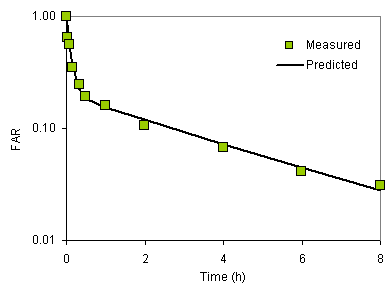Background and Keywords Information pertaining to the parameter estimation are specified in the following cluster of the input to the VC. NPAR = The number of parameters to be estimated. AMP(i) = The information necessary for the optimization calculation CID = The keyword under which the parameter to be optimized appearsPNAM = The parameter to be optimizedPLB = User specified lower bound for the specified parameterPUB = User specified upper bound for the specified parameterPIG = Primary initial guess for the optimization calculation A sample input statement will look like: MCAT: NPAR=3 !npar=2 or 3 for small datasets, npar=3-5 for large datasets
AMP1: CID=CLRP PNAM=RHT PLB=0.001 PUB=25 PIG=0.15 LI=1 !Simple DSB
AMP2: CID=CLRP PNAM=RHT PLB=0.001 PUB=1000 PIG=9 LI=2 !Complex DSB
AMP3: CID=IRAD PNAM=FCB PLB=0 PUB=1 PIG=0.2 !Fraction of DSB that are complex Example 18.1 An example of estimating the biological parameters: The repair half times for the slow and fast repair halftimes of DSB (RHT) and the fraction of DSB that are complex (FCB) FAR (fraction of DNA released) is reported with the Elapsed Time Since the end of Irradiation (ETSI) from a series of electrophoresis gel experiments. FAR is normalized to the value corresponding to ETSI = 0.0000 | Experiment No: | 1 | 2 | 3 | 4 | 5 | 6 | 7 | 8 | 9 | 10 | 11 | | ETSI (h) | 0.0000 | 0.0228 | 0.0806 | 0.1590 | 0.3230 | 0.4950 | 0.9880 | 1.9900 | 4.0000 | 5.9800 | 8.0000 | | FAR | 1.0000 | 0.6533 | 0.5617 | 0.3517 | 0.2467 | 0.1933 | 0.1608 | 0.1063 | 0.0673 | 0.0413 | 0.0307 |
The input file tlk_FAR_Noenzy.inp includes a description of the input parameters and calls for a data fit using the TLK model to optimize the parameters: the two repair half times (RHT) and the fraction of DSB that are complex (FCB). The input file describing the exposure scenarios and the FAR data are included in the file cho_far1.inp. Following the example 17.1 (together with the input file cho.inp) one obtains the xdat file required by VC for the parameter estimate calculation using the XIO utility. The resulting in output: tlk_FAR_Noenzy.out provides the estimated values for the desired parameters, the predicted FAR values and information regarding the goodness of the fit. Results show that the estimated parameters are: RHT (fast) = 0.08 hRHT (slow) = 4.26 h FCB = 0.2 A comparison of the measured and predicted data shows sufficient agreement as shown in Figure 1 (the results are usually shown on a semi-log or log-log plots).  Figure 1 Simulating the FAR data measured and those predicted by VC Suggested problems Figure 1 Simulating the FAR data measured and those predicted by VC Suggested problems- What information in the output file indicates the degree of success of the parameter fit?
- Perform a two parameter fit for the two repair half times (fix the FCB at the optimized value obtained using the three parameter fit) and observe the values of the new optimized repair half times. Compare them to those obtained from the three parameter fit. Explain your results.
- Change the primary initial guesses of the parameters being optimized and check if the optimized results are the same.
- Change the Lower bound of the fast repair half time to 0.1 h and observe the results of a three parameter fit. Are the results acceptable if the optimized parameter values reach any of the specified bounds? Explain your answer.
- What is the effect of changing the value of the standard error in the RADX file (cho_far1.inp) on the results of the parameter fit?
Tips: - If the parameter estimates do not approach the specified lower and upper bounds is favorable.
- The primary initial guess and the lower and upper bounds could be important in the final estimations.
- The simulation run time usually is less than 10 minutes of CPU time.
- If convergence is not reached within a reasonable period of time, input parameters may have to be changed.
- The program execution window provides useful information in following the progress of the calculation.
- A successful calculation should yield biologically plausible parameter values.
|


 Figure 1 Simulating the FAR data measured and those predicted by VC Suggested problems
Figure 1 Simulating the FAR data measured and those predicted by VC Suggested problems